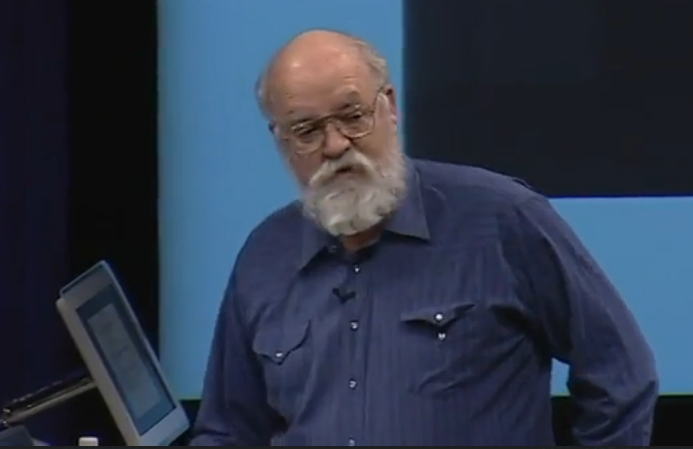The artist had very cleverly suggested people and clothes and wagons and all sorts of things,
艺术家很聪明地暗示了人物和服装,以及车马还有其他事物,
and my brain had taken the suggestion.
而我的大脑接受了这样的暗示。
You're familiar with a more recent technology, which is -- There,
你们很熟悉一个更新的技术,就在--这个。
you can get a better view of the blobs.
你们可以更好地看到颗粒。
See, when you get close they're really just blobs of paint.
看,当你移近时,他们就真的只是颜料粒。
You will have seen something like this -- this is the reverse effect.
你应该看过像这样的东西——相反的效果。
I'll just give that to you one more time.
我再来演示一次。
Now, what does your brain do when it takes the suggestion?
好,那么当你的大脑接受暗示时他做了什么呢?
When an artful blob of paint or two, by an artist, suggests a person
当艺术家的一两滴颜料粒暗示了一个人
say, one of Marvin Minsky's little society of mind
比如,一个Marvin Minsky的小社会心态
do they send little painters out to fill in all the details in your brain somewhere?
难道他们把小画家送到你的脑子里来填充所有细节?

I don't think so. Not a chance. But then, how on Earth is it done?
我觉得不是。没有任何可能,不过那样的话,那这些又到底是怎么回事?
Well, remember the philosopher's explanation of the lady?
还记得哲学家怎么解释那个被锯成两半的女士吗?
It's the same thing.
这是同一件事情。
The brain just makes you think that it's got the detail there.
大脑只是让你确信它得到了那处细节。
You think the detail's there, but it isn't there.
你想着细节在那里,但是他不在。
The brain isn't actually putting the detail in your head at all.
大脑并没有把细节放入脑海中。
It's just making you expect the detail.
它只是让你期待细节。
Let's just do this experiment very quickly.
让我们快速地过下这个试验。
Is the shape on the left the same as the shape on the right, rotated? Yes.
左边的形状旋转后是不是与右边的完全相同?是的。
How many of you did it by rotating the one on the left in your mind's eye,
多少人把左边的形状旋转了,在想象中,
to see if it matched up with the one on the right?
来看它是否与右边那个一致?
How many of you rotated the one on the right? OK.
有多少人旋转的是右边那个?好的。
How do you know that's what you did?
你怎么知道那就是你所作的?
There's in fact been a very interesting debate raging for over 20 years in cognitive science
实际上这有个非常有趣的争论,在认知科学领域持续了20年
various experiments started by Roger Shepherd,
由Roger Shepherd开始的各种试验,
who measured the angular velocity of rotation of mental images.
他测量了人的意识中图像的旋转角速度。
Yes, it's possible to do that.
是的,这是做得到的。
But the details of the process are still in significant controversy.
但是过程的细节还有着明显的争议。
And if you read that literature, one of the things that you really have to come to terms with is
如果你阅读相关的文献,有件事情你一定要妥协的是
even when you're the subject in the experiment, you don't know.
即使你是实验对象,你也无从知道。
You don't know how you do it.
你不知道你是怎么做到的。
You just know that you have certain beliefs.
你只是知道你有特定的信念
And they come in a certain order, at a certain time.
他们在特定的时间以特定的顺序出现。
And what explains the fact that that's what you think?
那么,如何解释“那就是你所想的”这个事实呢?
Well, that's where you have to go backstage and ask the magician.
那,你就要到后台去问魔术师了。
This is a figure that I love: Bradley, Petrie, and Dumais.
这是我喜欢的图示:Bradley, Petrie,以及 Dumais。
You may think that I've cheated, that I've put a little whiter-than-white boundary there.
你可能觉得我在骗你,通过放置一些不显眼的边界。
How many of you see that sort of boundary, with the Necker cube floating in front of the circles?
多少人看到了那种边界,通过把内克尔方块放在圆圈的前面?
Can you see it?
你可以看到吗?
Well, you know, in effect, the boundary's really there, in a certain sense.
看起来,在特定情境下,是有边界的。
Your brain is actually computing that boundary, the boundary that goes right there.
你的大脑计算出了那种边界,让边界出现在那里。











